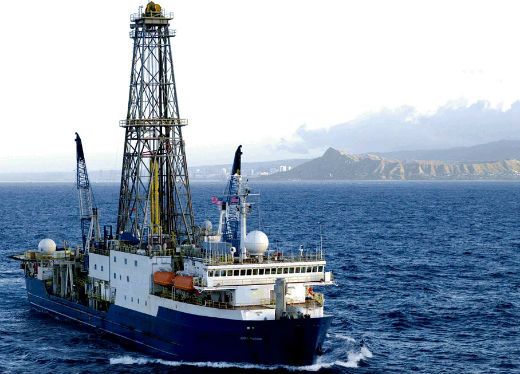Scientists from across the world are coming to New Zealand over the next couple of years to take part in an unprecedented series of investigations into the seafloor using a specially designed scientific drilling ship.
Confirmation of the five back-to-back research voyages in New Zealand waters, starting in August 2017, caps off years of planning and preparatory work by hundreds of scientists from many countries.
The US-based scientific research ship JOIDES Resolution expected in August 2017. Photo: Supplied
The US-based scientific research ship JOIDES Resolution will complete multiple drill holes beneath the ocean floor at four locations off the New Zealand coast, and one in the Ross Sea, to collect a range of information about how planet Earth works that can only be obtained by drilling into the seafloor.
The ship is operated by the International Ocean Discovery Program (IODP) which has 26 member countries, including New Zealand and all major trading partners.
Cumulatively the five projects represent a science investment of over $NZ80 million in terms of operating costs.
For many of the scientists, participation in these expeditions will be the pinnacle of their careers.
The ship will spend about 12 months in New Zealand waters with each of the five legs lasting about two months. It will make multiple port visits, each time spending millions of dollars on fuel and provisions.
Dr Neal Wai Poi, Acting Chief Executive of GNS Science, whose scientists are leading or co-leading two of the expeditions, said all of the projects encompassed themes of global significance and would lead to major advances in understanding for earth sciences.
The five projects are:
• Drill into the Tasman Sea, northwest of the North Island, to discover how and why tectonic plate subduction began about 50 million years ago and determine the influence this has had on regional and global climate, particularly a period of intense warming 50 million years ago when there were palm trees in Antarctica (led by Victoria University of Wellington)
• Test if slow deformation of a large seafloor landslide (about the size of Auckland), 30km off the Gisborne coast, is linked to the occurrence of gas hydrates by sampling the sub-seafloor layer along which the slide mass is moving (led by The University of Auckland)
• Recover drill cores from beneath the seafloor off the Ross Ice Shelf to gain an improved understanding of the behaviour and stability of the West Antarctic Ice Sheet through multiple cycles of warming and cooling during the past 20 million years (led by Victoria University of Wellington)
• Drill and install sub-seafloor borehole observatories, about 50km off the coast of Gisborne, along the Hikurangi subduction zone, to learn about slow earthquakes and develop a capability for giving early warnings of damaging earthquakes and tsunamis (led by GNS Science)
• Probe the active Brothers Volcano, about 400km northeast of the Bay of Plenty coast, to investigate the transport of hot fluids and metals in the Earth's crust an learn about the conditions for microbial life inside submarine volcanoes (led by GNS Science).
Dr Wai Poi said the projects would deliver a number of positive impacts for New Zealand and would enable a global perspective on some of today's most pressing societal challenges. These include:
• An improved understanding of the Earth's climate and oceans and how they will respond to rapid environmental changes in the coming decades
• An improved assessment of earthquake and tsunami hazards and establishment a long-term borehole observatory to monitor tectonic plate behaviour off the East Coast of the North Island.
New Zealand's involvement in the International Ocean Discovery Program comprises GNS Science, Victoria University of Wellington, NIWA, and Otago University, together with a number of Australian universities and government organisations.
Additional benefits from IODP activities in New Zealand include:
• Enhancing science diplomacy and creating international collaboration across science disciplines and providing access to samples and analysis of geological processes in New Zealand's marine territory that can be acquired in no other way
• Providing invaluable training opportunities for the next generation of New Zealand scientists and engineers and delivering unrivalled opportunities for students, teachers, and the public to engage with science.



3 comments
jobs for Kiwi seafarers??
Posted on 09-06-2016 08:19 | By Captain Sensible
Hope NZ seafarers will be employed on this vessel whilst in NZ waters, or will the govt grant another dispensation to allow foreigners to take NZ jobs?
jobs for kiwis
Posted on 09-06-2016 10:43 | By Petrolhead
I cant see a US specialist vessel taking on Kiwi crew 2mths a year, irrespective of any govt intervention. What I can see is jobs for NZ scientists from GNS and Universities, jobs supported by the millions of dollars injected into local economy running the ship and potential spin off jobs in the future depending on what they find. Sounds like a well lobbied and delivered program of work by a large group of hardworking NZ organiations - awesome stuff
@ petrolhead
Posted on 09-06-2016 11:50 | By Captain Sensible
When a vessel works the NZ coast and gets a special dispensation to not employ kiwis, then next they will choose to employ foreigners in shore side jobs and neglect locals. The only time we can't employ foreigners as opposed to kiwis, is in politics where our MPs are safe from foreigners who, could no doubt, do a better job. Why should Kiwi seafarers be unemployed while a foreigner takes their job?
Leave a Comment
You must be logged in to make a comment.